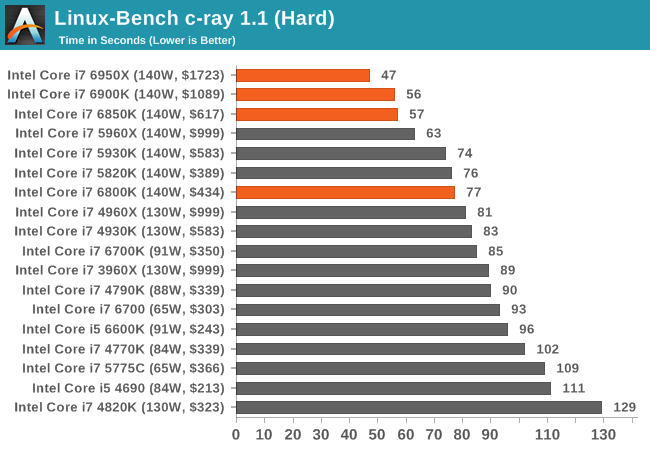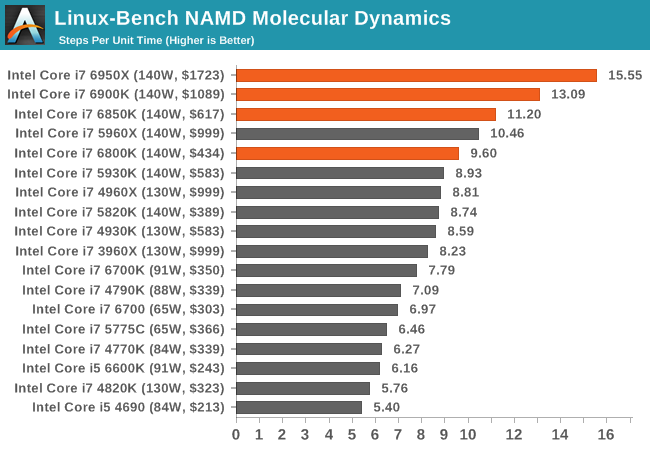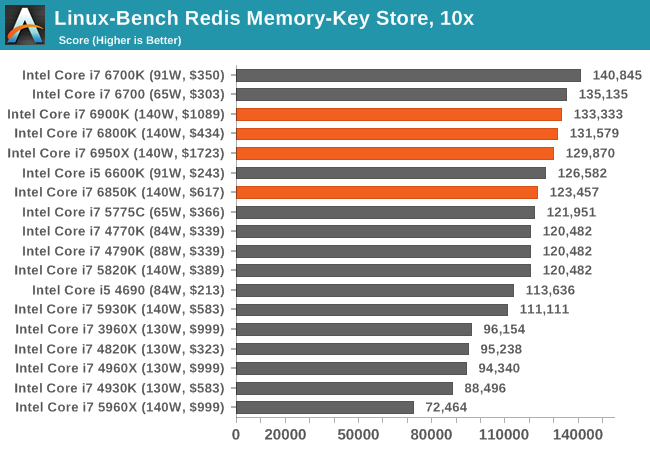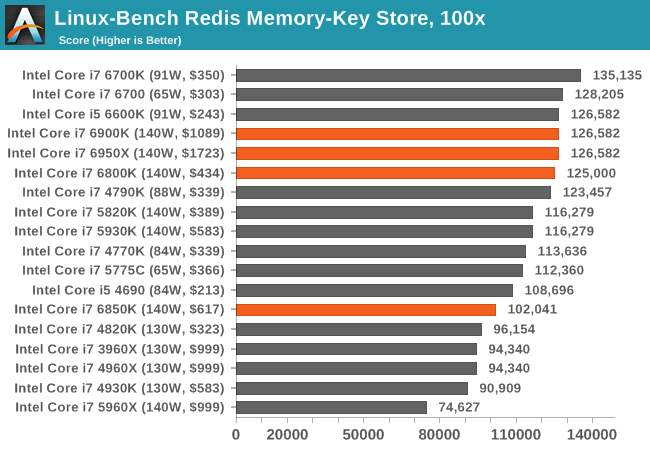The Intel Broadwell-E Review: Core i7-6950X, i7-6900K, i7-6850K and i7-6800K Tested
by Ian Cutress on May 31, 2016 2:01 AM EST- Posted in
- CPUs
- Intel
- Enterprise
- Prosumer
- X99
- 14nm
- Broadwell-E
- HEDT
Linux Performance
Built around several freely available benchmarks for Linux, Linux-Bench is a project spearheaded by Patrick at ServeTheHome to streamline about a dozen of these tests in a single neat package run via a set of three commands using an Ubuntu 11.04 LiveCD. These tests include fluid dynamics used by NASA, ray-tracing, OpenSSL, molecular modeling, and a scalable data structure server for web deployments. We run Linux-Bench and have chosen to report a select few of the tests that rely on CPU and DRAM speed.
C-Ray: link
C-Ray is a simple ray-tracing program that focuses almost exclusively on processor performance rather than DRAM access. The test in Linux-Bench renders a heavy complex scene offering a large scalable scenario.

NAMD, Scalable Molecular Dynamics: link
Developed by the Theoretical and Computational Biophysics Group at the University of Illinois at Urbana-Champaign, NAMD is a set of parallel molecular dynamics codes for extreme parallelization up to and beyond 200,000 cores. The reference paper detailing NAMD has over 4000 citations, and our testing runs a small simulation where the calculation steps per unit time is the output vector.

Redis: link
Many of the online applications rely on key-value caches and data structure servers to operate. Redis is an open-source, scalable web technology with a strong developer base, but also relies heavily on memory bandwidth as well as CPU performance.
[words]












205 Comments
View All Comments
JimmiG - Tuesday, May 31, 2016 - link
What's worse than the price premium is that you're also paying for the previous generation architecture.I really don't see why anyone would want one of those CPUs. For gaming and most typical applications, the mainstream models are actually faster because of their more modern architecture and higher clock speeds. If you're a professional user, you should really be looking at Xeons rather than these server rejects.
K_Space - Tuesday, May 31, 2016 - link
Exactly. I think that's the whole point: Intel realizes that -realistically- little profit will be made from these B-Es given the little incremental increase in performance so why not use them as an advert for the Xeons (which they have aggressively been marketing for HEDT not just servers over the last few month). Anyone considering these will consider the Xeons now.Ratman6161 - Tuesday, May 31, 2016 - link
There are a few benchmarks where they do make sense, if and only if you are doing that particular task for your job i.e. an environment where time is money. For the rest of us, if I need to do a video conversion of some kind its relatively rare and I can always start it before I go to bed.retrospooty - Tuesday, May 31, 2016 - link
People belittle AMD because even though Intel has dramatically slowed down the pursuit of speed, AMD still cant catch up. It's actually worse than that though. If AMD were competitive at all in the past decade Intel would still be perusing speed and would be further ahead. Its a double edged sword sort of thing.Flunk - Tuesday, May 31, 2016 - link
Yes, Intel has slowed down for AMD to catch up before. Cough, Pentium 4.retrospooty - Tuesday, May 31, 2016 - link
Yup... and back then AMD took advantage of it. I was the happy owner of a Thunderbird, then an Athlon, then an Athlon X2... Then Intel woke up and AMD went to sleep. For the past decade AMD has been too far behind to even matter. In the desktop CPU space there is Intel and then ... no-one.Flunk - Tuesday, May 31, 2016 - link
You're right, it's totally Intel's fault. They could launch a line of high-end consumer chips that cost the same as the current i5/i7 line but had 2-3X as many cores but no iGPU. They'd cost Intel the same to fabricate. They're the only ones to blame for their slowing sales.khon - Tuesday, May 31, 2016 - link
I could see people buying the i7-6850K for gaming, 6 cores at decent speeds + 40 PCI-E lanes, and $600 is not that bad when consider that some people have $700 1080's in SLI.However, the i7-6900/6950 look like they are for professional users only.
RussianSensation - Tuesday, May 31, 2016 - link
40 PCI lanes are worthless when i7 6700K can reliably overclock to 4.7-4.8Ghz, and has extra PCIe 3.0 lanes off the chipset. The 6850K will be lucky to get 4.5Ghz, and still lose in 99% of gaming scenarios. Z170 PCIe lanes are sufficient for 1080 SLI and PCIe 3.0 x4 in RAID.6850K is the worst processor in the entire Broadwell-E line.
Impulses - Tuesday, May 31, 2016 - link
Well if you're about gaming only you might as well compare it with the 6600K... AFAIK HT doesn't do much for gaming does it? The 6800K isn't much better either when your can just save a few bucks with the 5820K.I feel like they could've earned some goodwill despite the high end price hikes by just putting out a single 68xx SKU for like $500, it'd still be a relative price hike for entry into HEDT but could be more easily seen as a good value.
Are the 6800K bad die harvests or something? Seems dumb to keep that artificial segmentation in place otherwise when HEDT is already pretty far removed from the mainstream platform.
When I chose the 6700K over the 5820K I thought it'd be the last quad core I'd buy, but at this pace (price hikes, HEDT lagging further behind, lower end SKU still lane limited) I don't know if that'll be true.